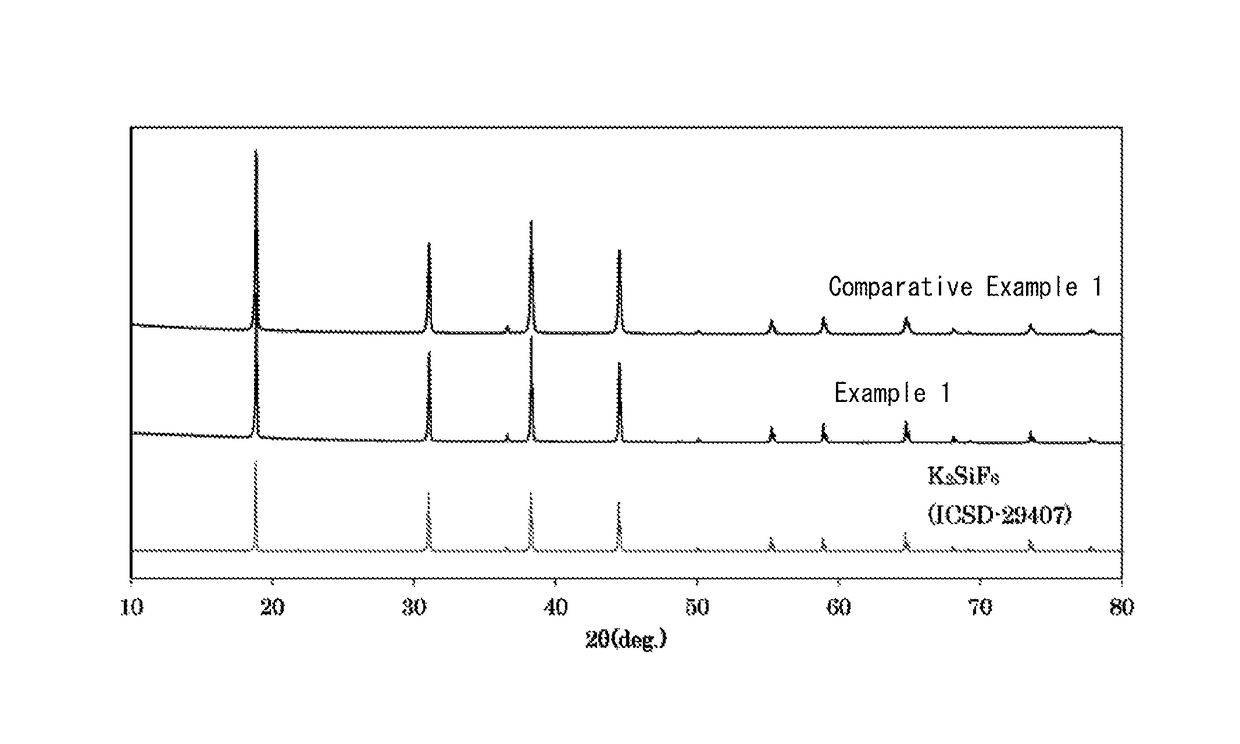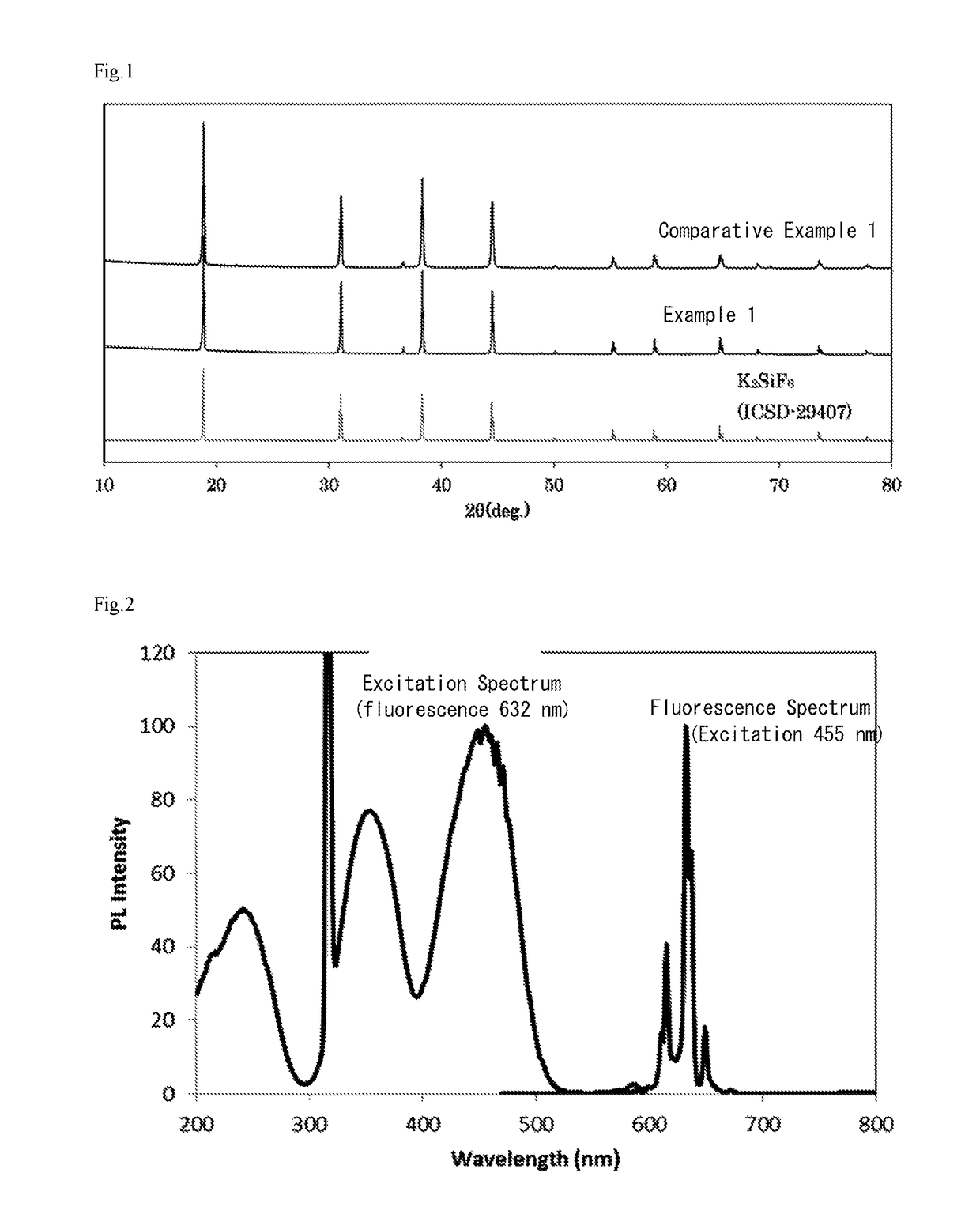Phosphor, light emitting element, and light emitting device
a light emitting element and phosphor technology, applied in the direction of luminescent compositions, semiconductor devices, chemistry apparatus and processes, etc., can solve the problems of difficulty in achieving high luminance and poor color rendering properties of white leds, and achieve high color reproducibility, high color rendering properties, and high color reproducibility.
- Summary
- Abstract
- Description
- Claims
- Application Information
AI Technical Summary
Benefits of technology
Problems solved by technology
Method used
Image
Examples
examples
[0051]Herebelow, the present invention will be described in further detail by means of the examples indicated below.
2MnF6>
[0052]First, the production method of K2MnF6 used as the Mn raw material of the phosphor in the following examples and comparative examples will be explained.
[0053]800 ml of hydrofluoric acid at a concentration of 40 mass % was poured into a Teflon (registered trademark) beaker with a capacity of 1 liter, and 260 g of KHF2 powder (special grade chemical manufactured by Wako Pure Chemical Industries) and 12 g of potassium permanganate powder (grade 1 chemical manufactured by Wako Pure Chemical Industries) were dissolved.
[0054]While stirring the hydrofluoric acid reactant using a magnetic stirrer, 8 ml of 30% hydrogen peroxide water (special grade chemical manufactured by Wako Pure Chemical Industries) were dripped in a little at a time. When the dripped amount of hydrogen peroxide water exceeded a standard amount, yellow particles began to precipitate, and the col...
example 1
[0059]20 g of the phosphor of Comparative Example 1 were added to 100 ml of a mixed solution (volume ratio 1:1) of hydrofluoric acid having a concentration of 20% and methanol to prepare a suspension.
[0060]While stirring this suspension, 25 ml of an aqueous solution of calcium nitrate having a concentration of 0.6 mol % were added. After addition, the suspension was further stirred for 10 minutes. After the stirring ended, the suspension was let stand to allow the phosphor to settle, and the operation of removing the supernatant, adding methanol thereto, stirring and allowing to stand, then removing the supernatant and further adding methanol was repeated until the solution became neutral.
[0061]Thereafter, the precipitated particles were recovered by filtration, and further dried to completely remove the methanol by evaporation, resulting in the phosphor of Example 1.
example 4
[0063]20 g of the phosphor of Comparative Example 1 were added to 100 ml of a mixed solution (volume ratio 1:1) of hydrofluoric acid having a concentration of 20% and methanol to prepare a suspension.
[0064]While stirring this suspension, 20 ml of an aqueous solution of calcium chloride having a concentration of 0.6 mol % were added. After addition, the suspension was further stirred for 10 minutes. After the stirring ended, the suspension was let stand to allow the phosphor to settle, and the operation of removing the supernatant, adding methanol thereto, stirring and allowing to stand, then removing the supernatant and further adding methanol was repeated until the solution became neutral.
[0065]Thereafter, the precipitated particles were recovered by filtration, and further dried to completely remove the methanol by evaporation, resulting in the phosphor of Example 4.
PUM
| Property | Measurement | Unit |
|---|---|---|
| depth | aaaaa | aaaaa |
| depth | aaaaa | aaaaa |
| wavelengths | aaaaa | aaaaa |
Abstract
Description
Claims
Application Information
 Login to View More
Login to View More - R&D
- Intellectual Property
- Life Sciences
- Materials
- Tech Scout
- Unparalleled Data Quality
- Higher Quality Content
- 60% Fewer Hallucinations
Browse by: Latest US Patents, China's latest patents, Technical Efficacy Thesaurus, Application Domain, Technology Topic, Popular Technical Reports.
© 2025 PatSnap. All rights reserved.Legal|Privacy policy|Modern Slavery Act Transparency Statement|Sitemap|About US| Contact US: help@patsnap.com



